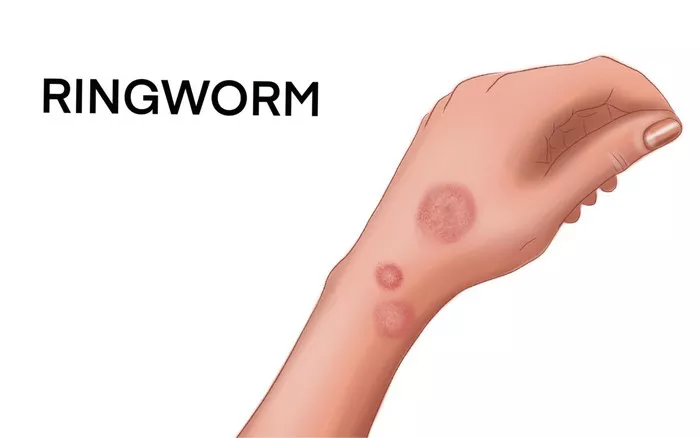Ringworm, also known as dermatophytosis or tinea, is a common fungal infection that affects the skin, hair, and nails. Despite its name, ringworm is not caused by a worm but by various species of fungi called dermatophytes. This condition is highly contagious and can spread through direct contact with an infected person or animal, or by touching contaminated objects and surfaces. The infection presents itself as a red, circular, itchy rash with a raised border, often resembling a ring, hence the name “ringworm.” A common question among those affected is whether ringworm will eventually go away on its own or requires treatment. This article explores the nature of ringworm, its causes, symptoms, treatment options, and the likelihood of it resolving without intervention.
Understanding Ringworm
Ringworm can affect different parts of the body, each presenting unique symptoms and requiring specific treatment approaches. The types of ringworm include:
- Tinea Corporis: Affects the body, usually presenting as circular, red, and scaly patches.
- Tinea Pedis (Athlete’s Foot): Affects the feet, causing itching, scaling, and sometimes blistering.
- Tinea Cruris (Jock Itch): Affects the groin area, leading to red, itchy patches.
- Tinea Capitis: Affects the scalp, resulting in scaly, bald patches.
- Tinea Unguium (Onychomycosis): Affects the nails, causing them to become thick, discolored, and brittle.
- Tinea Barbae: Affects the beard area, leading to red, inflamed patches.
Causes and Risk Factors
Ringworm is caused by dermatophytes, which thrive in warm, moist environments. Factors that increase the risk of contracting ringworm include:
- Close Contact: With an infected person or animal.
- Sharing Personal Items: Such as towels, clothing, and grooming tools.
- Warm, Humid Environments: That promote fungal growth.
- Compromised Immune System: Making the body less able to fight off infections.
- Participating in Sports: Especially those involving close physical contact.
Symptoms of Ringworm
The symptoms of ringworm vary depending on the affected area but generally include:
- Red, Circular Rash: With a raised border and clear center.
- Itching: Which can range from mild to severe.
- Scaling and Cracking: Of the skin.
- Blisters: Which may ooze and crust over in severe cases.
- Hair Loss: In areas where the scalp or beard is affected.
Diagnosis of Ringworm
A healthcare provider can diagnose ringworm through:
- Physical Examination: Noting the characteristic appearance of the rash.
- Skin Scrapings: Examined under a microscope to identify fungal elements.
- Culture Tests: Where a sample is grown in a lab to confirm the type of fungus.
Treatment Options
Treating ringworm effectively requires antifungal medications, which can be topical or oral, depending on the severity and location of the infection.
- Topical Antifungals: Creams, lotions, or powders applied directly to the affected area. Common over-the-counter options include clotrimazole, miconazole, and terbinafine.
- Oral Antifungals: Prescribed for more severe or widespread infections, including griseofulvin, terbinafine, and itraconazole.
Will Ringworm Go Away on Its Own?
The question of whether ringworm will eventually go away without treatment is complex. In some cases, ringworm may resolve spontaneously, especially if the individual’s immune system is strong. However, relying on self-resolution is not advisable for several reasons:
- Prolonged Discomfort: Ringworm is itchy and uncomfortable, and allowing it to persist can lead to unnecessary suffering.
- Risk of Spreading: The infection can spread to other parts of the body or to other individuals.
- Secondary Infections: Scratching the itchy areas can break the skin, leading to bacterial infections.
- Chronic Infection: Untreated ringworm can become chronic and more difficult to eradicate.
SEE ALSO: The 6 Best Antifungal Cream for Groin Ringworm
Preventing Ringworm
Preventing ringworm involves good hygiene practices and avoiding contact with infected individuals or animals. Key prevention strategies include:
- Keep Skin Clean and Dry: Particularly in areas prone to moisture buildup.
- Avoid Sharing Personal Items: Such as towels, clothing, and grooming tools.
- Wear Protective Footwear: In communal showers or locker rooms.
- Treat Infected Pets: To prevent transmission to humans.
- Practice Good Hand Hygiene: Washing hands regularly, especially after handling animals or contaminated items.
When to Seek Medical Attention
It is important to seek medical attention if:
- Symptoms Persist: Despite over-the-counter treatments.
- Infection Spreads: To multiple areas of the body.
- Severe Symptoms Develop: Such as extensive blistering, pain, or secondary bacterial infection.
- Immune System is Compromised: Making self-treatment less effective.
Conclusion
While ringworm may eventually go away on its own in some cases, it is generally not advisable to leave it untreated. The discomfort, risk of spreading, and potential for secondary infections make prompt and effective treatment the best approach. Antifungal medications, both topical and oral, are highly effective in eradicating the infection and preventing recurrence. Good hygiene practices and preventive measures can help reduce the risk of contracting and spreading ringworm. If symptoms persist or worsen, seeking medical attention is crucial to ensure proper treatment and management of the infection.
Related Topics:
























